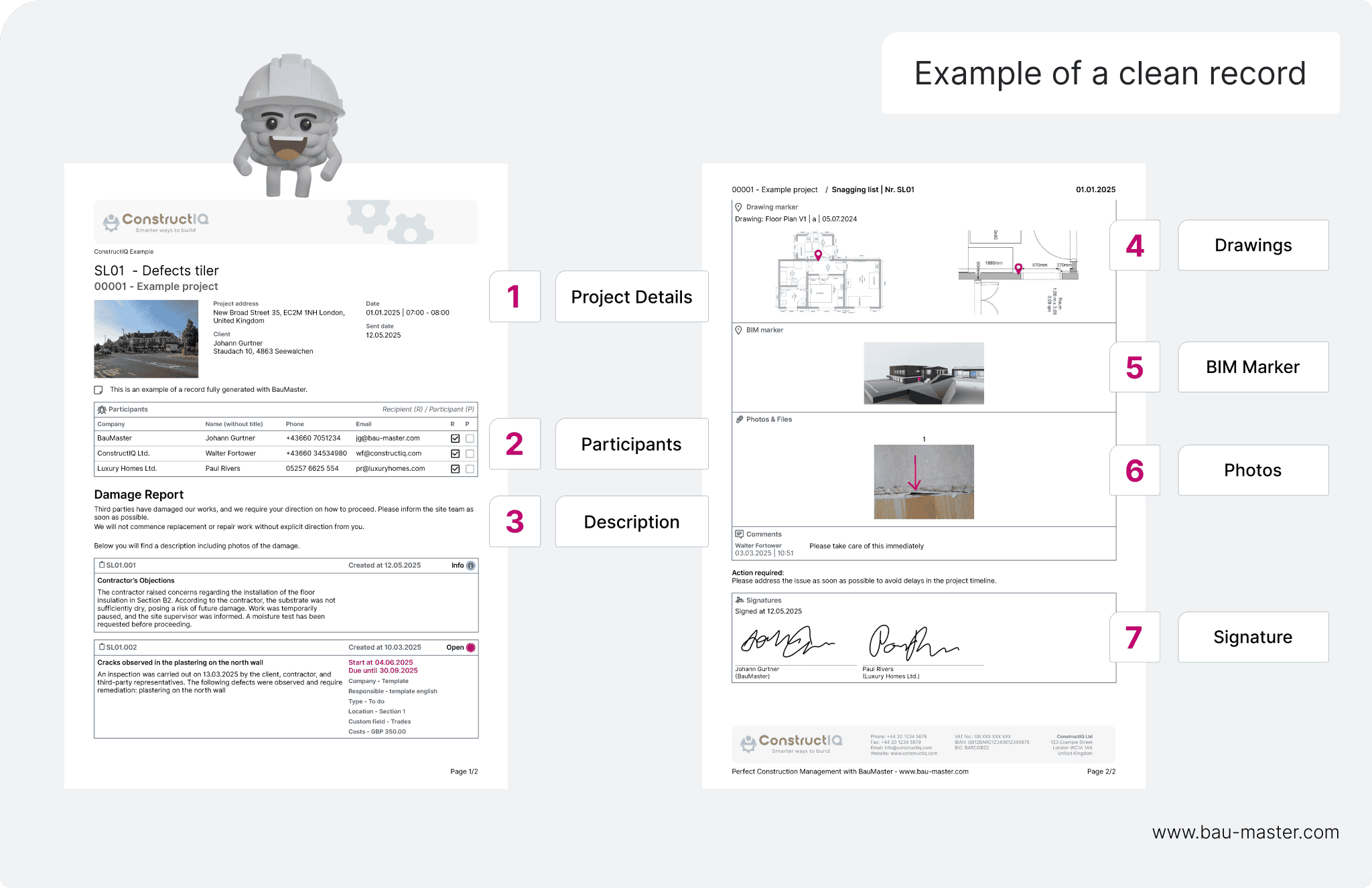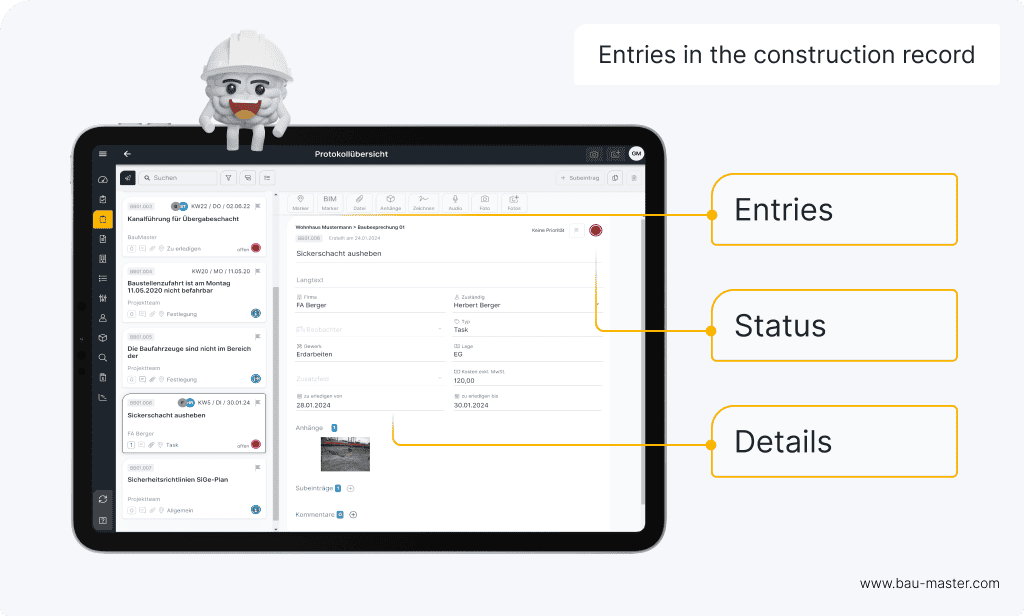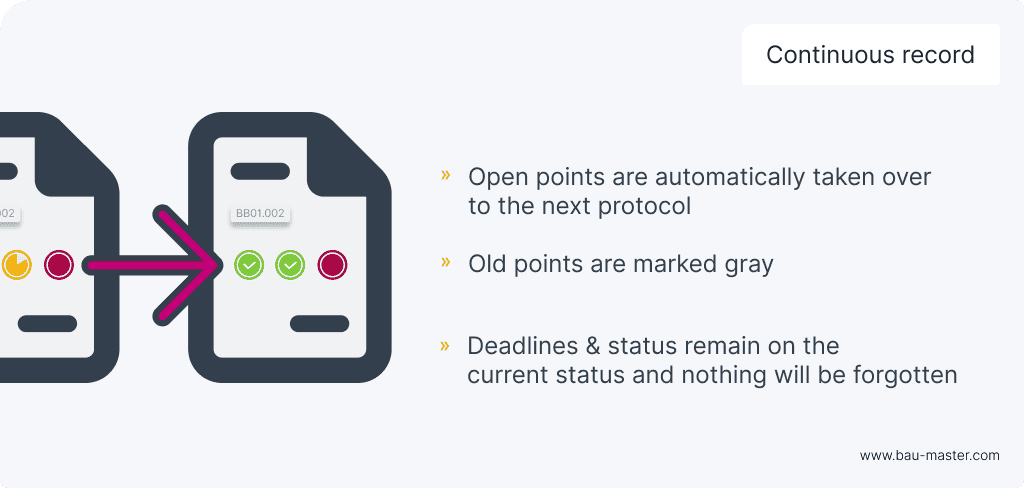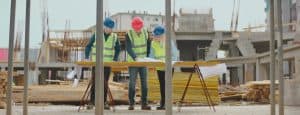Writing meeting minutes is often seen as an unwelcome task that nobody volunteers for. Yet, well-prepared construction meeting minutes are essential for documenting all agreements, deadlines, and arrangements on site. In this guide, we explain why these records are so important, what a construction minutes of meeting template might look like, and what both parties should keep in mind.
- Why are regular construction meetings important?
- What are meeting minutes?
- Why are meeting minutes so important?
- Meeting minutes template for construction: what should be included?
- Tips for site managers and architects
- Tips for contractors
- Ongoing site meeting minutes with BauMaster templates
- Achieving success with professional construction meeting minutes
Construction meeting & minutes at a glance
Why schedule regular construction team meetings?
They keep all stakeholders aligned, help identify issues early, support collaboration, and ensure steady progress toward deadlines and project goals.
What are meeting minutes?
They’re written records of key discussions, decisions, and responsibilities from project meetings – crucial for communication, traceability, and legal protection.
Why are they important?
They ensure clarity, reduce misunderstandings, document evidence for disputes, and keep all stakeholders informed – even those who missed the meeting.
What should be included?
A good meeting minutes template includes project info, the meeting date, attendees and absent parties, agenda, agreements, and deadlines.
Who is responsible for writing them?
Usually the site manager or a designated party; they must sign the minutes, while others may but are not required to.
Why go digital for construction meeting minutes?
Digital tools like BauMaster streamline workflows, centralise records, prevent data loss, and support transparent, ongoing documentation.
Why are regular construction meetings important?
Construction meetings are essential for keeping projects on track. They bring together stakeholders – such as site managers, architects, contractors, and clients – to review progress, resolve issues, and align on next steps. Whether weekly team meetings or monthly progress check-ins, regular meetings help prevent delays and ensure coordination.
Construction projects typically involve several recurring meeting types, such as the following:
onstruction meetings also serve as a platform for decision-making, risk management, and accountability. And while the meeting itself is important, proper documentation is what ensures lasting impact. That’s where meeting minutes come in.
What are meeting minutes?
Meeting minutes are written records that capture the key points, decisions, and agreed actions discussed during a meeting. In construction projects, they serve as a vital communication tool between all parties – site managers, architects, contractors, and clients. Properly maintained meeting minutes provide a transparent, chronological account of discussions and responsibilities, helping to avoid misunderstandings and ensuring accountability.
They also serve as legal documentation in case of disputes and are an essential part of professional project management.
What are construction meeting minutes?
Construction meeting minutes capture key information discussed by site managers, planners, tradespeople, and, where applicable, the client. These may include:
1. Updates on upcoming or completed work
2. Technical execution details
3. Changes in procedure or plan modifications
4. New deadlines and schedules
5. And more
The minutes serve as a shared foundation for ongoing construction activities. The goal is to ensure that every step of the construction process can be traced back clearly, even at a later stage.
Why are meeting minutes so important?
Meeting minutes are almost as crucial to project management as the meetings themselves. During these typically weekly sessions, key decisions and scheduling agreements are made – making it vital to record them in written form. Below, we highlight three strong reasons why keeping proper documentation of these discussions is essential:
Clear and transparent communication
Construction minutes of meeting ensure that all parties have a clear understanding of the agreed procedures, helping to avoid any loss of information. When it’s documented who attended, what topics were discussed, and what decisions were made, the risk of misunderstandings is significantly reduced.
This also helps to keep future meetings efficient and to the point. Recurring issues won’t need to be discussed repeatedly, as everyone can refer back to the written record. Instead of asking again, team members can simply look up what was said and decided.
Securing evidence
If problems or disputes arise – such as hidden construction defects discovered years later – construction meeting minutes play a crucial role in resolving them constructively. They document participants, agreements made, and significant changes. Without such records, disputes often devolve into word-against-word situations.
This typically leads to lengthy proceedings involving handwritten notes, expensive expert assessments, and mutual accusations. Properly kept meeting minutes make it much easier to reconstruct the facts and identify responsibilities. Time and energy that would otherwise be spent untangling these issues are far better invested in the actual project.
Information sharing
Meeting minutes are equally important for individuals who were unable to attend—perhaps due to scheduling conflicts or other obligations. Without a written record, they would have to rely on second-hand information, which always carries the risk of miscommunication or missing details.
In addition, there are often external parties who need to be informed about specific decisions or developments, such as neighbours or local authorities. A detailed meeting minutes template (for construction) ensures that everyone who needs the information receives it in a clear and accurate format.
Why digital meeting minutes are a smart choice
To ensure that all parties have access to key documents and updates at any time, using digital construction meeting minutes is highly recommended over handwritten notes. This approach not only makes the information more accessible and centralised, but also saves the person responsible from having to manually type up and distribute the document after each site meeting.
By digitising your meeting minutes, you reduce the potential for errors and ensure a more efficient workflow—leaving more time for the actual project work.
Meeting minutes template for construction: what should be included?
Professional meeting minutes should be as detailed as possible to preserve information for future reference. A consistent format makes it easier to stay organised and avoid overlooking important points. That’s why having a clear meeting minutes template for projects is highly beneficial. A typical weekly construction meeting covers and documents the following:
Formal Components
When creating a template for your meeting minutes, completeness is key. The more comprehensive the document, the more useful it becomes for managing defects or resolving disputes later on.
For example, the following elements are commonly included in a construction minutes of meeting template:

Topics & meeting content
When filling out the meeting minutes template, the bulk of the content naturally stems from the meeting itself. Typical topics for construction meeting agenda include follow-ups from the previous session, scheduling matters, reassignment of responsibilities, other updates, and questions or suggestions from participants regarding the project’s progress.
It’s important to strike the right balance: the scope should be neither too broad nor too narrow. Major planning issues that don’t affect all participants should be dealt with separately. Similarly, conflicts with individual parties should be addressed in one-on-one meetings – not in the general record.
Of course, not all attendees will strictly follow this scope. However, the written minutes should stay focused on the essentials to avoid confusion, especially for third parties. It should also never be used to single out specific contractors in front of others.
Tips for site managers and architects
For clients and project leaders, it’s especially important to keep some key questions in mind: Are construction meeting minutes mandatory? Who is responsible for writing them – and do they need to be signed?
Is it mandatory to keep construction meeting minutes?
Comprehensive site supervision – including coordination tasks – is an essential part of the duties of architects and engineers. Often, the obligation to keep meeting minutes is specified as part of the construction contract. Such a provision ensures legal certainty and sets clear expectations for all parties involved.
Who should be responsible for writing the minutes?
In most cases, the site manager is responsible for documenting the construction meeting. However, the task can also be assigned to another party – ideally someone neutral and independent. It’s best to clarify this responsibility at the very beginning of the project to ensure a consistent and uninterrupted documentation process throughout.
Do construction meeting minutes need to be signed?
Meeting minutes should always include the signature of the person who prepared them. However, signatures from other parties are not mandatory – unless a formal confirmation is explicitly required.
Tips for contractors
Construction meeting minutes are not only relevant for clients – executing companies also rely heavily on the information recorded in them. As a contractor, it’s essential to be aware of your rights if a protocol contains an incorrect entry that may put you at a disadvantage.
In principle, the contents of construction meeting minutes are considered binding – especially if signed by the contractor. If you notice an error in the meeting minutes that does not reflect what was actually discussed, ignoring it is not advisable. Always review the minutes as soon as you receive them and respond promptly to any inaccuracies.
Ideally, objections should be made within a few days after receiving the document. Waiting weeks or even months can make it difficult – or impossible – to reconstruct what was said. Submit your objection in writing to ensure you have documented proof of your response.
Ongoing site meeting minutes with BauMaster templates
For both site managers and contractors, replacing handwritten notes with a modern construction software solution is a smart move. With digital meeting minutes, you streamline your workflow, eliminate the clutter of paper-based records, and free up valuable time for more critical tasks.
BauMaster enables you to keep a continuous, well-structured record of your construction meetings – directly based on proven templates. This ensures clarity and legal certainty and boosts collaboration across all project stakeholders.

Digital construction management is not only practical for daily operations – it also ensures that all protocols and relevant information are stored centrally, making it easy to revisit details years later when handling defects or resolving disputes.

With BauMaster, you benefit from a continuous construction meeting protocol: one protocol entry is extended until project management assigns it the status “completed.” That means each project has a single, living document until all open items are resolved. Tasks and information can no longer get lost – giving you complete transparency from initial planning to final handover.
Achieving success with professional construction meeting minutes
Thorough documentation is essential on every construction site to maintain structure and clarity. A solid construction team meeting protocol allows all parties to review important information at any time, keep track of deadlines, and clearly identify responsibilities in case of defects.
Whether you are a client or a contractor – equipped with the knowledge provided here and the right digital tools like BauMaster, your next construction project is set for success!









